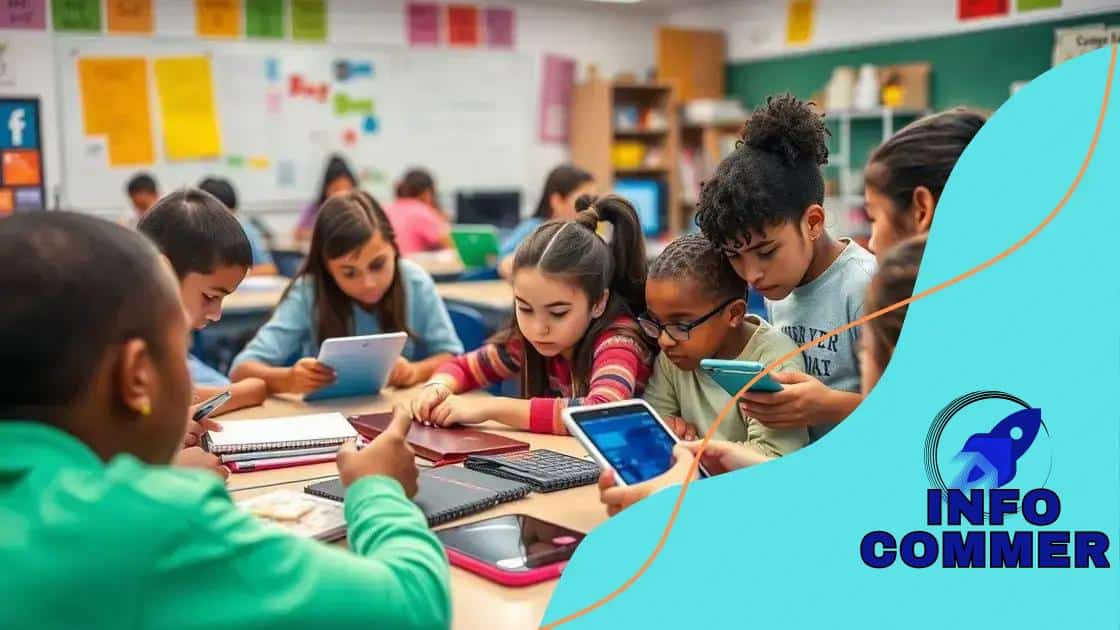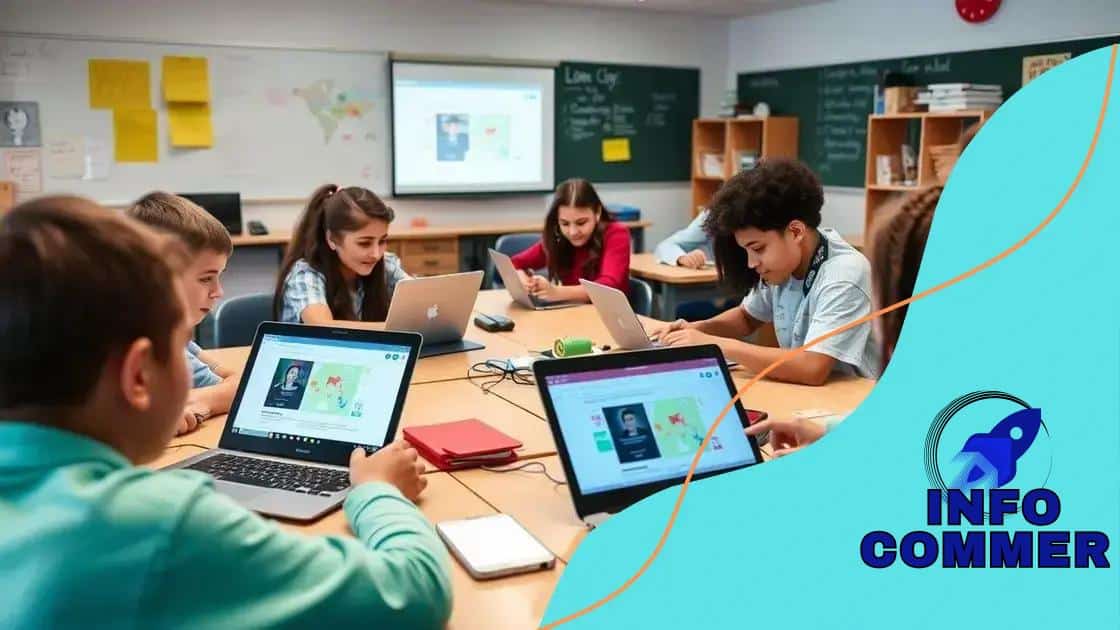Collaborative learning environments in digital classrooms

Collaborative learning environments in digital classrooms enhance engagement, foster teamwork, and improve critical thinking skills among students through interactive tools and effective strategies.
Collaborative learning environments in digital classrooms are reshaping how students engage with each other and their education. Have you ever wondered how technology can make learning more interactive and fun? Let’s dive into this fascinating topic.
Understanding collaborative learning
Understanding collaborative learning is essential in today’s educational landscape. This approach encourages students to work together, fostering communication and teamwork. It is not just about sharing answers, but about deepening understanding through collaboration.
Key Concepts of Collaborative Learning
In collaborative learning environments, students benefit from various interactions. They can learn from peers and develop critical thinking. The following are key concepts to keep in mind:
- Active participation: Each student has a role, ensuring everyone contributes.
- Mutual respect: Students learn to value each other’s ideas and perspectives.
- Shared responsibility: Success depends on the group’s effort, encouraging teamwork.
As students engage in collaborative learning, they also enhance their social skills. The discussions that occur during group work expose them to diverse viewpoints. These interactions can lead to higher retention of knowledge as well, since the process of teaching and explaining concepts solidifies understanding.
Benefits of Collaborative Learning
Engaging in collaborative learning offers numerous advantages. For instance, it helps students develop essential life skills such as problem-solving and communication. By working with others, they tackle challenges, share insights, and refine their thinking.
Moreover, collaborative learning fosters a sense of belonging. When students feel they are part of a team, they become more motivated. This motivation can lead to improved performance in their studies. They will also become more confident in expressing their ideas.
In conclusion, understanding collaborative learning sets the foundation for creating a more interactive and engaging classroom. By emphasizing teamwork and communication, educators can enhance the learning experience for all students.
Benefits of digital classrooms
Benefits of digital classrooms are transforming education as we know it. By incorporating technology, students can experience learning in a more meaningful and engaging way. The flexibility provided by digital classrooms allows learners to access resources anytime and anywhere.
Enhanced Engagement
Digital classrooms promote higher levels of student engagement. Interactive tools like quizzes, discussion boards, and multimedia presentations make learning exciting. With these features, students are less likely to be passive learners.
- Interactive tools: Students can participate in real-time feedback sessions.
- Variety of resources: A wide range of materials enhances understanding.
- Immediate access: Students can find information quickly and efficiently.
Moreover, digital classrooms accommodate different learning styles, allowing students to learn at their own pace. Whether someone prefers watching videos, reading, or hands-on activities, digital platforms offer tailored experiences for everyone.
Collaboration Opportunities
Another advantage of digital classrooms is the ability to collaborate with peers seamlessly. Students can work on projects together, even if they are in different locations. This not only builds teamwork skills but also promotes deeper understanding through discussion.
Access to global resources and experts also expands opportunities for learning. Students can connect with professionals, enhancing their education beyond local boundaries. Such platforms encourage cultural exchange and broaden perspectives.
In summary, the benefits of digital classrooms create a dynamic educational environment that fosters engagement, collaboration, and personalized learning experiences.
Tools for collaboration in education

Tools for collaboration in education are essential for enhancing the learning experience. These tools not only facilitate communication but also create an interactive environment. By using the right technology, students can work together effectively, regardless of their physical locations.
Popular Collaboration Tools
There are numerous tools available that support collaborative learning. These platforms help students share ideas, organize projects, and communicate in real-time.
- Google Workspace: This set of tools, including Docs, Sheets, and Slides, allows multiple users to work on documents at the same time.
- Microsoft Teams: A platform for chat, video conferencing, and file sharing that encourages teamwork and communication.
- Miro: This online whiteboard tool helps students brainstorm and create visual project plans together.
- Trello: A project management tool that helps teams organize tasks and track progress visually.
Using these tools, students gain hands-on experience with technology, which is crucial in today’s digital world. Each application offers unique features that cater to different collaborative needs. For instance, while Google Workspace focuses on document editing, Miro promotes creative brainstorming.
Benefits of Collaboration Tools
Incorporating collaboration tools into education enhances learning outcomes. They encourage students to engage actively and communicate openly, fostering a sense of community. Furthermore, these tools prepare students for future workplace environments where collaboration is key.
Collaboration tools also support inclusive education. They allow students with diverse learning needs to participate fully in group activities. By accommodating various learning styles, teachers can ensure that every student feels included and valued.
Overall, the right tools for collaboration in education create a more dynamic and engaging learning atmosphere, allowing students to thrive both academically and socially.
Strategies to enhance student engagement
Strategies to enhance student engagement play a vital role in creating a dynamic learning environment. Engaged students are more likely to participate actively, leading to better outcomes. Educators can implement various techniques to boost students’ interest and involvement.
Interactive Learning Techniques
One effective approach is using interactive learning techniques. Activities like group discussions, role-playing, and hands-on experiments help students connect with the material. These methods make learning enjoyable and memorable.
- Group projects: Encourage teamwork and collaboration among peers.
- Gamification: Integrate game elements to create competition and fun.
- Hands-on activities: Allow students to explore concepts through experimentation.
Additionally, incorporating technology can significantly enhance engagement. Utilizing tools like videos, simulations, and interactive software captures students’ attention. With technology, lessons can come to life, making them more relatable.
Building a Supportive Classroom Environment
A supportive classroom environment is crucial. When students feel safe and valued, they are more likely to express their thoughts and ideas. Creating a culture of respect and open communication encourages participation.
Teachers can also provide regular feedback and encouragement. Acknowledging students’ efforts boosts their confidence and motivates them to engage further. Moreover, setting clear expectations and involving students in goal-setting fosters ownership of their learning.
Ultimately, using various strategies to enhance student engagement can transform the classroom experience. By making learning interactive and building a positive environment, educators can inspire students to take an active role in their education.
Measuring success in collaborative learning
Measuring success in collaborative learning is essential for understanding how well students are working together. It helps educators identify what is effective and what can be improved. Various metrics can gauge the impact of collaborative efforts in the classroom.
Observation and Feedback
One method is through observation and feedback. Teachers can assess how students interact during group activities. Observing group dynamics provides valuable insights into student participation and engagement levels.
- Participation rates: Monitor how often each student contributes to discussions.
- Quality of interaction: Evaluate how students communicate and collaborate with one another.
- Peer feedback: Encourage students to give constructive feedback to their classmates.
This observational data can help teachers adapt their strategies to better meet students’ needs. Equally important is asking for student feedback on their collaborative experiences. Surveys or informal discussions can provide insights into what students find effective or challenging.
Academic Performance
Another way to measure success is by analyzing academic performance. Comparing test scores, project grades, and other assessments before and after collaborative activities can show improvements. Tracking growth helps gauge whether collaborative learning positively affects understanding and retention of material.
In addition, understanding the development of soft skills is crucial. Skills such as teamwork, communication, and problem-solving can be assessed through self-reflection or specific assessments focused on these areas. These metrics can demonstrate how collaboration is impacting students beyond academic achievements.
Overall, effective measuring of success in collaborative learning involves a combination of qualitative and quantitative methods. Teachers can create a comprehensive view of how collaboration benefits students intellectually and socially.
In conclusion, successful collaborative learning environments benefit both students and educators. By implementing effective tools and strategies, classrooms become more engaging and supportive. Measuring success through observations, feedback, and academic performance helps ensure that all students thrive. By focusing on collaboration, we prepare students for the future, fostering skills they will use throughout their lives.
FAQ – Frequently Asked Questions about Collaborative Learning Environments
What are the main benefits of collaborative learning?
Collaborative learning fosters teamwork, enhances engagement, and promotes critical thinking skills among students.
How can teachers measure success in collaborative learning?
Teachers can measure success through observations, feedback, academic performance, and assessing soft skills development.
What tools can enhance collaboration in education?
Tools like Google Workspace, Microsoft Teams, and Miro facilitate communication and project management among students.
How can I boost student engagement in the classroom?
Using interactive learning techniques, technology, and creating a supportive classroom environment can significantly boost student engagement.





